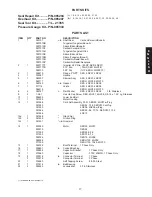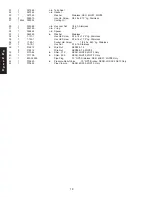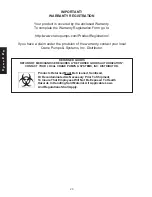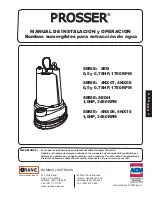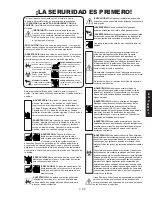
9
Apply pipe sealant to pressure gauge assembly and tighten
into pipe plug hole (see Fig. 2). Pressurize motor housing
to 10 P.S.I. Use a soap solution around the sealed areas
and inspect joints for “air bubbles”. If, after fi ve minutes,
the pressure is still holding constant, and no “bubbles” are
observed, slowly bleed the pressure and remove the gauge
assembly. Replace the pipe plug using a sealant. If the
pressure does not hold, then the leak must be located.
CAUTION ! - Pressure builds up extremely
fast, increase pressure by “TAPPING” air
nozzle. Too much pressure will damage
seal. DO NOT exceed 10 P.S.I. in motor
housing.
F-2) Impeller, Volute and Exclusion Seal Service:
F-2.1) Disassembly and Inspection:
To clean out volute (7), disconnect power, remove cap
screws (34) and lockwashers (22), vertically lift motor and
seal assembly from body (7). Clean out body if necessary.
Inspect gasket (24) and replace if cut or damaged. Clean and
examine impeller (2) for pitting, wear, cracks or breakage,
replace if required.
If impeller (2) requires replacing, remove jam nut (29) by
placing a fl at screwdriver in the slot of the end of the shaft to
hold the shaft stationary while unscrewing the impeller (2).
Once impeller (2) is removed, remove spacer (32) on SED
series or spacer (32) and shims (39) & (40) on SEDH series,
and exclusion seal (31) if damaged or cut.
F-2.2) Reassembly:
Position exclusion seal (31) on shaft until it seats against the
stationary portion of seal (1). On SED series pumps place
spacer (32) on shaft until it seats against exclusion seal (31).
On SEDH series pumps place spacer (32) and shims (39)
& (40) on shaft until it seats against exclusion seal (31). To
install impeller (2), clean the threads with loctite cleaner and
screw impeller (2) onto the shaft hand tight. Apply thread
locking compound to shaft threads and install nut (29). On
SEDH series pumps shim to within .005/.015 from Impeller
to Volute. Torque to 40 ft. lbs. Rotate impeller to check for
binding.
Position impeller and motor assembly on volute (7). Apply
thread locking compound to cap screw (34) and position
lockwasher (22) on cap screw (34) and screw into volute
(7). Torque to 8 ft. lbs. Check for free rotation of motor and
impeller.
F-3) Motor, Bearing and Seal Service
F-3.1) Disassembly and Inspection:
To examine or replace the motor (14), bearing (21) and
shaft seal (1), disassemble volute and impeller as outlined
in paragraph F-2.1. Drain oil from motor as outlined in
paragraph F-1.3.
Position unit upright, using blocks to avoid resting unit on
shaft. Remove gland nut (12b), friction rings (12c) and
grommet (12d) from motor housing (11), see Figure 6.
Remove socket head cap screws (36) and lift motor housing
(11) from lower end bell (10). Slide motor housing (11) up
cable (12), until wire connectors and ground screw are
exposed. Remove cable lead wires from motor lead wires by
disconnecting wire connectors (19) and ground screw (20)
from motor (14). The wiring connections should be noted to
insure correct connections when reassembling.
Motor -
Remove the motor bolts and lift motor stator from
motor rotor and lower end bell (10). Unscrew conduit bushing
(16) from lower end bell (10) and lift motor rotor, shaft,
bearing (21), rotating portion of seal (1), washers (25) & (33),
and conduit bushing (16) from lower end bell (10). Inspect
windings for shorts and check resistance values. Check rotor
for wear, if rotor or the stator windings are defective, the
complete motor must be replaced.
To test the temperature sensor (if equipped), check the
continuity between the black and white wires. If found to be
defective contact a motor service station or Barnes Service
Department. Check motor capacitor (18) on single phase
units with an Ohm meter by fi rst grounding the capacitor
by placing a screwdriver across both terminals and then
removing screwdriver. Connect Ohm meter (set on high
scale) to terminals, if needle moves to infi nity (
∞
) then
drifts back, the capacitor is good. If needle does not move
or moves to infi nity (
∞
) and does not drift back, replace
capacitor (18).
Seal -
Remove rotating member (1a), spring (1c) and
retaining ring (1d) from shaft. (see Figure 3). Examine all seal
parts and especially contact faces. Inspect seal for signs of
wear such as uneven wear pattern on stationary members,
chips and scratches on either seal face.
DO NOT
interchange
seal components, replace the entire shaft seal (1). If replacing
seal, remove stationary (1a) from lower end bell (10) by
prying out with fl at screwdriver.
CAUTION ! - Handle seal parts with extreme care.
DO NOT scratch or mar lapped surfaces.
Bearing -
Examine bearing (21) and replace if required. If
replacement is required, remove bearing (21) from motor
shaft using a wheel puller. Washers (25), (33) and conduit
bushing (16) can now be removed from motor shaft.
IMPORTANT ! - All parts must be clean before
reassembly.
FIGURE 2
E
N
G
L
I
S
H
Pressure Gauge
Assy
Remove Plug
Í
10 PSI AIR
Summary of Contents for PROSSER 4NX07 Series
Page 14: ...14 FIGURE 8 Series SED 4NX07 4NX08 E N G L I S H ...
Page 15: ...15 FIGURE 9 Series SEDH 4NX09 4NX10 E N G L I S H ...
Page 16: ...16 FIGURE 10 SEDH Series 4NX09 4NX10 SED Series 4NX07 4NX08 Series SED SEDH 4NX E N G L I S H ...
Page 35: ...15 SP E S P A Ñ O L FIGURA 8 Serie SED 4NX07 4NX08 ...
Page 36: ...16 SP E S P A Ñ O L FIGURA 9 Serie SEDH 4NX09 4NX10 ...
Page 42: ...E S P A Ñ O L ...

















